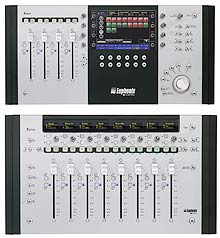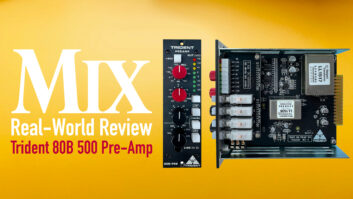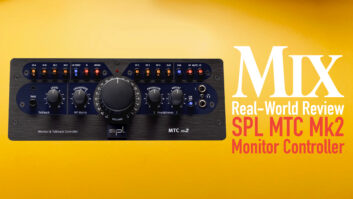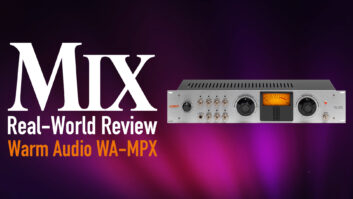
MC Mix (top) offers eight faders, eight touch-sensitive controllers and eight info displays. MC Control features 12 assignable soft-keys, four touch-sensitive faders and eight rotary encoders.
Long known as a manufacturer of high-end products, Euphonix has recently ventured down-market, targeting Mac-based DAW users with two affordable products under a new brand. Euphonix’ Artist Series comprises the MC Mix, an 8-channel system with touch-sensitive faders, rotary encoders and high-contrast OLED displays; and the companion (or stand-alone) MC Control, which offers four faders, dedicated transport controls, 12 programmable buttons and a 6×3.5-inch, touch-sensitive color LCD.
These new units use technologies from the company’s MC Pro, including extensive customization of controls, the ability to switch control instantly between multiple applications and even the capacity to transfer control to a second computer workstation. Both products work under Euphonix’ EuCon control protocol, which is integrated into DAWs from Apple, Steinberg and MOTU.
Setup and EuControl
While unpacking these units, I noticed handy fold-down feet on the bottom of the controllers. These raise the angle of the worksurface but don’t lock in place, so sliding the MCs forward or back made the feet fold up, which became tiresome. Fortunately, included risers attach to the bottom, so a full-sized Apple keyboard can sit comfortably in front — problem solved. Removable side panels let you physically connect multiple MCs together for an integrated console look. The MCs communicate via an Ethernet connection; after wiring them to my network switch and plugging in the AC adapters, I was ready to rock.
The brains behind the Artist Series is the EuControl application, which appears as an “E” icon in the menu bar. A green “E” confirmed that my Mac recognized the MC units. EuControl is “application-aware,” allowing it to instantly switch control between multiple programs. As I use Logic Pro as my main music tool and Soundtrack Pro as my audio editor, I had the perfect scenario for testing this system. Logic Pro has built-in EuCon support — there’s no need to configure anything. Both MCs immediately reflected Logic’s mixer as soon as my project opened. Soundtrack Pro doesn’t support EuCon, so I set the Euphonix MC control panel to tell the MCs to use Mackie Control Universal Emulation mode whenever Soundtrack Pro was active. Once configured, switching between the two apps automatically remapped all of the controls instantly. The MCs even have a button for switching programs from the surface.
Delving Into the MC Control
The MC Control has some important features that don’t appear on the MC Mix, such as dedicated transport controls including a jog/shuttle wheel. The small button size and the way the keys are oriented around the jog wheel didn’t feel right with my layout: The low-profile detented dial didn’t provide a positive connection with my hand.
However, the MC Control really shines with its touchscreen and 12 programmable buttons, each of whose current function is indicated in the bottom of the screen. With its pre-mapped settings for popular apps, I instantly realized this system’s power. For example, in Logic Pro, the first button is used for tool selection; in Soundtrack Pro, it toggles the Cycle mode; and for Safari, the same button opens a new Web browser. And pressing the soft-key setting on the touchscreen reveals 24 more virtual buttons, providing instant access to 36 software functions at one time. For me, the best part of the MC Control was the ability to customize every button for the functions that I wanted using EuControl’s Soft-Key editor, which even let me color-code the displays on the touchscreen.
The MC Control has four faders, but unlike the MC Mix it has no dedicated display above them. Information (such as channel track names) is displayed to the right of the faders at the top of the touchscreen. I prefer having channel information visually connected to the fader, but was able to adapt quickly. Four rotary encoders flanking each side of the touchscreen provide control over many parameters. For instance, after selecting a track in Logic, I used these to configure the channel strip settings, such as I/O, aux sends, inserts and panning. Each encoder’s function is displayed in the adjacent area in the touchscreen.
The encoders also have a push-button. The upper-right encoder that says “pan” didn’t control panning, which seemed strange. You must first press the Pan encoder like a button and then turn the only pan parameter, which is now on the encoder on the upper-left side. This happens because MC Control uses a layer system for the encoders, and the first layer is simply used to select the category of controls you want to look at. As there’s only one pan parameter for most tracks, it seems silly to have to navigate to a second layer just to move the shaker track to the left speaker. For all other channel strip parameters, the layered approach works well.
Pressing the Inserts encoder displays the names of the plug-ins in the first eight insert slots next to each encoder. Editing a plug-in was easy: I pressed its encoder and the first eight parameters of that plug were mapped to the eight encoders for adjusting parameter values. If more than eight parameters are offered, the Page buttons can move to the next set of parameters. One flaw with this system is that some plug-ins have so many parameters that your favorites may be spread across multiple pages. The MC doesn’t provide a way to map the most important parameters to a single page. In Logic, this is possible using a $200 MIDI fader box that outputs generic Continuous Control numbers. It would be nice if the MCs provided a MIDI CC mode to get around this problem.
Next up: MC Mix
The MC Mix lacks MC Control’s flashy screen and programmable buttons, but I like its dedicated rotary encoders and displays above each channel. Selecting and editing channel strip parameters is similar to that of the MC Control, but MC Mix gives you an additional set of Select and On buttons next to each encoder. One notable advantage of the MC Mix over the MC Control is that the former can flip parameters from the encoders onto the faders — a real plus when doing automation moves or building headphone mixes. I also like EuControl’s option to bank the faders of the MC Mix and MC Control independently so you can view two parts of your mix at the same time.
Automation and Mute/Solo
I automate more than just fader moves and I enjoy working with touch-sensitive encoders. Most control surfaces lack touch-sensitive knobs, making work in touch-automation mode less than intuitive as the DAW can’t recognize an intent to update a parameter until the knob moves. With the MC units, as soon as I place my finger on the encoder, Logic started to write data. It was during the automation tests that I came across my biggest disappointment with these surfaces. Quick taps of buttons didn’t always register, which was particularly annoying when I was trying to perform mute automation. Although this is less critical, I also noticed a sluggish response with soft-keys. I was able to work around this by being a bit more deliberate when pressing buttons. Fortunately, the fader control and touch response on the encoders felt great.
You can mute and solo tracks from either surface, but the MC Control offers an innovative way to perform these basic functions. Click the Track soft-key on the touchscreen and it displays a 32-block grid of the channels in the project. By tapping the blocks you can solo, mute, record-enable or select tracks. Unfortunately, you can’t slide a finger across a range of tracks to solo or mute on either unit, but this display seems to offer the fastest way of finding tracks in large projects.
Studio Monitor Express
A feature not to be overlooked is an application called Studio Monitor Express (SME). SME let me use the MC Control and my MOTU 896HD for conventional control room monitoring functions by intercepting the audio signal between the application’s output and the audio interface. Once configured, the MC Control’s dedicated Control Room speaker-level knob and the touchscreen offered options like sum-to-mono and even talkback capability without having to modify anything in my Logic project. I really like this approach, which is a feature that is absent on most other controller systems.
End of the Test Drive
If you’re a Mac-based DAW owner, MC Control and MC Mix will change how you work. Their controls have deep feature sets and let you quickly switch between applications, as well as completely customize the units’ look and operation for your own needs. Despite minor complaints I have about the ergonomics and the inability to map favored plug-in parameters on the surface, the positives are overwhelming, making MC Control and MC Mix a solid, small-footprint control choice for command and control of your audio applications.
Robert Brock is an audio consultant, musician and engineer.








